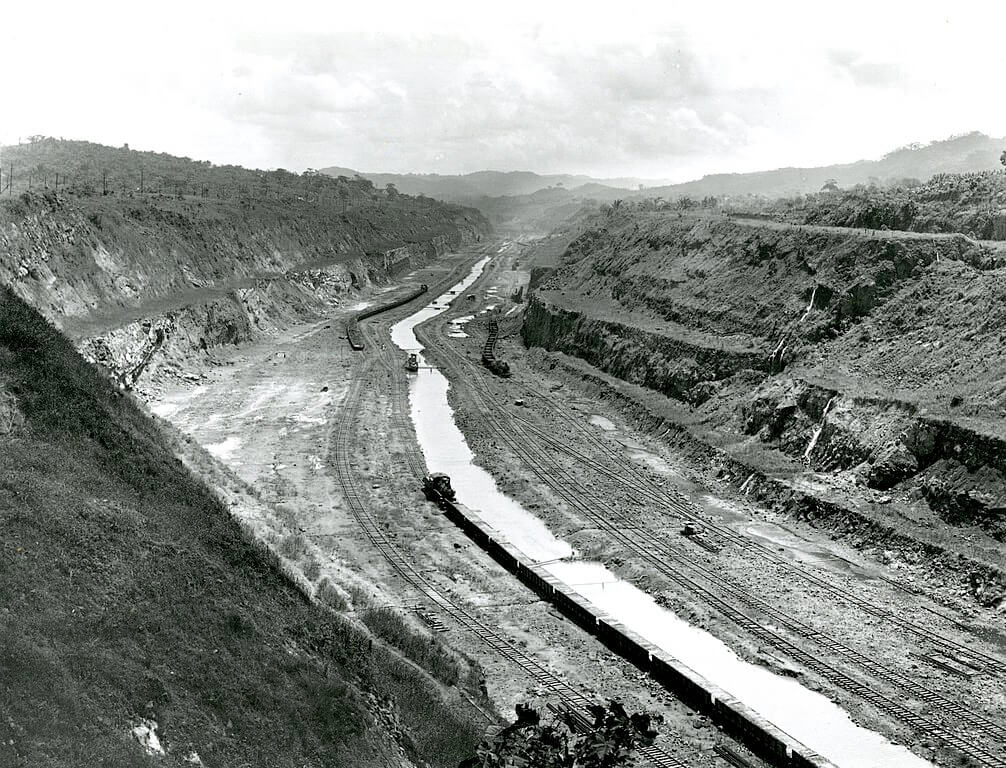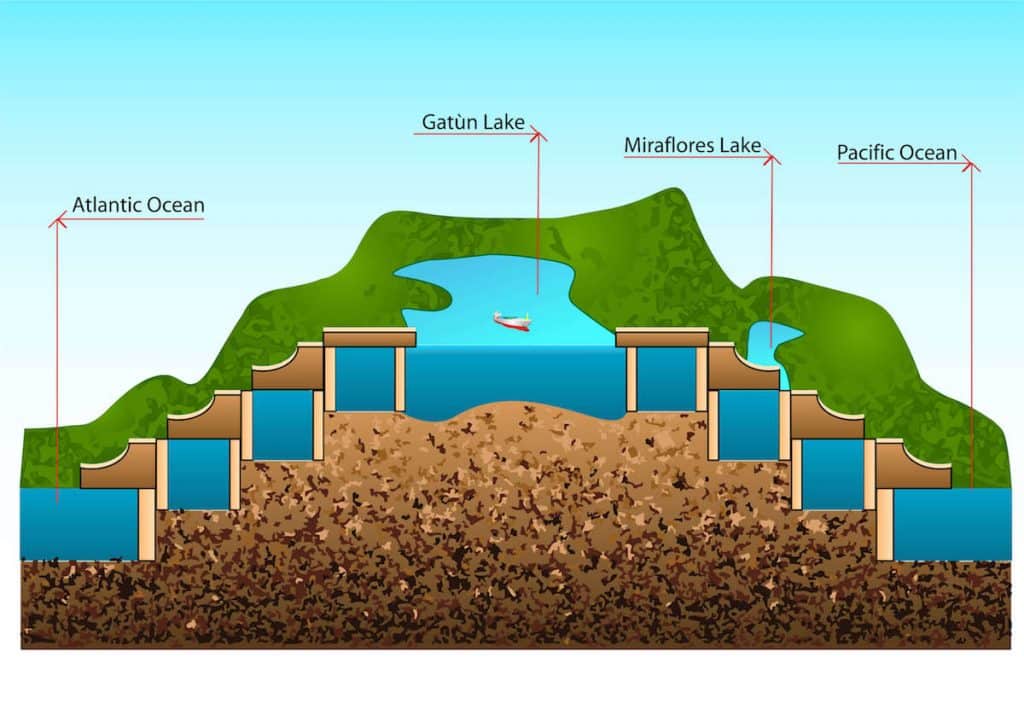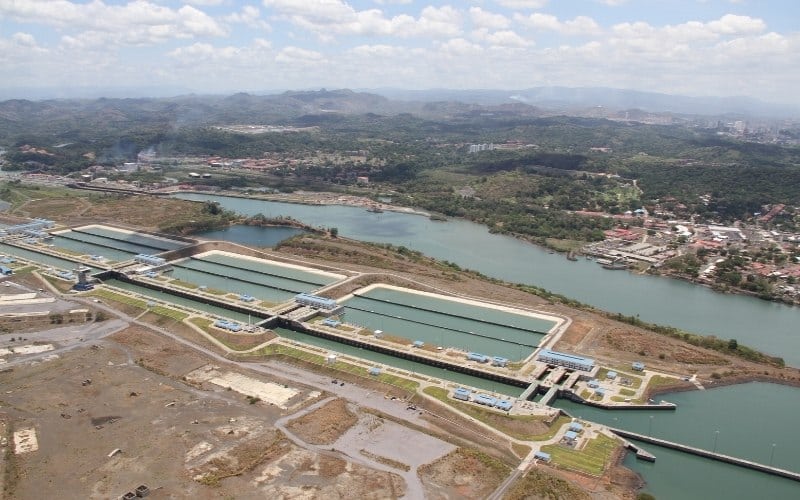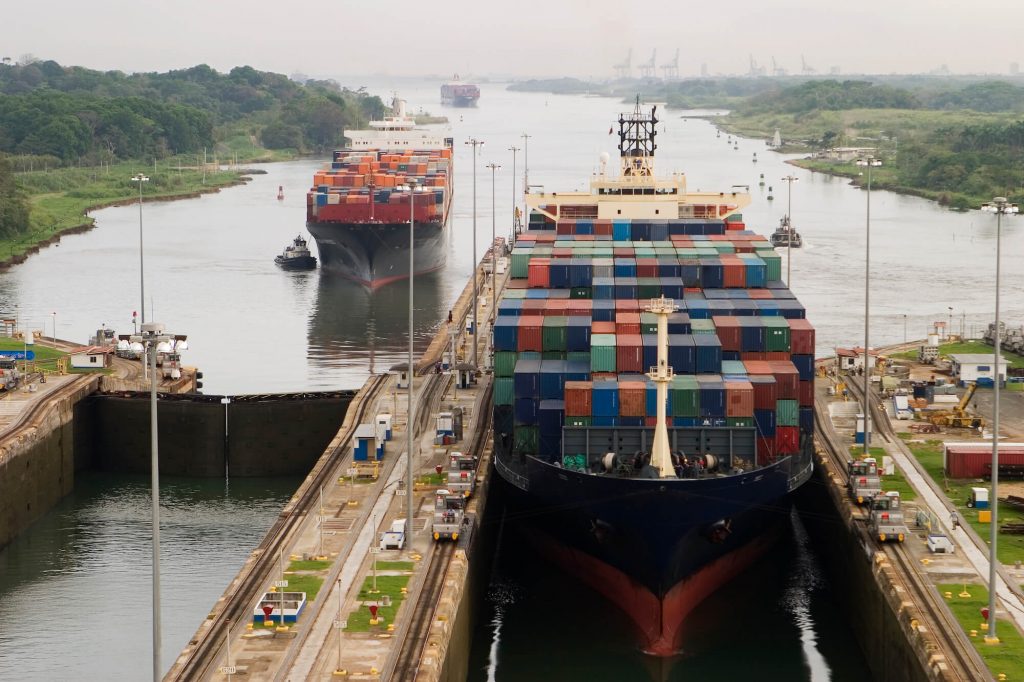How Many Miles Can Be Saved by Cutting Through the Panama Canal
"Take you ever crossed Panama Canal?" One of many questions we mariners encounter while interacting with landlubbers, if they are smart enough non to ask questions like "where practice you sleep at dark on ship?".
Panama Canal is perhaps one the most remarkable feats of applied science ever conceived by the whole of mankind. Its sheer size tells a beautiful tale almost man endurance, determination and achievement.
Related Reading: x Famous Aircraft Canals In The World
As a seafarer, I would say we are a privileged lot who get to meet the Panama Canal in a very intimate manner past actually sailing through information technology. Thus information technology would not exist incorrect to mention that it is a kind of moral obligation for us mariners to know few intricate facts about it.
Let's take a look at ten important Panama Canal facts below:
1. Who Congenital The Panama Canal?
Everyone knows that the Panama Culvert was congenital past the United states of America, but very few know that work was in fact started by the French. Information technology was Mr Ferdinand de Lesseps, a French diplomat who offset started the work back in 1881. The work had to be stopped in the twelvemonth 1894 considering yellow fever and malaria claimed the lives of an estimated 22,000 workers and spending nearly USD $ 287 million bankrupted Mr Ferdinand de Lesseps.

The left over work was undertaken by Americans in the year 1904 after helping Panama sacrifice from onetime 'Greater Colombia'. Under the able leadership of Mr John Frank Stevens and later Major George Washington Goethals as master engineer, they were able to complete the work in 10 years. Information technology was on 15th August 1914, full two years before the target year of 1916, when the Panama Canal was officially inaugurated.
Related Read:A Cursory History of the Panama Canal
2. Which was the first vessel to cross the Panama Canal?
As per records available, the kickoff ship to cross Panama Culvert was SS Ancon. She was an American flag cargo and rider ship owned by Boston Steam Transport Company. She was almost 150 meters in length, 18 meters in beam, about 9600 Gross Registered Tonnage and drew a draft of about viii.viii meters. She played a very of import role in edifice the canal by ferrying workers, construction textile and notably massive amounts of cement from New York to Panama for construction of Panama Canal.
3. How much time is saved by crossing the Panama Canal?
Panama Canal was first envisioned past Charles V Holy Roman Emperor and king of Espana in the twelvemonth 1534. He was convinced that a canal across the isthmus of Panama would profoundly reduce the altitude between Kingdom of spain and Peru, thus giving them a military reward over Portuguese. Though it took nearly four centuries for his dream to materialize, since its inauguration, Panama Canal has reduced the sailing distance from Atlantic to Pacific and vice versa by a huge 8000 nautical miles (approximately). If we canvas with an average speed of about say 15 knots, then it will be 22 long days!
On the reverse, it takes just around 8 to 10 hours to cross the Panama Canal. Panama Canal non only saves money and time for owners and ship operators just in fact, it helps in saving huge amounts of CO2 emissions and thus helping the shipping industry to reduce its carbon footprint.
Panama Canal Facts Infographic:

four. How much does it price to transit the Panama Canal?
Panama Canal authorities calculate tolls by using a system called Panama Canal Universal Measurement System (PC/UMS), which is based on international standard of vessel measurement established past International Convention of Measurement of Ships 1969.
To determine net Canal Tonnage a mathematical formula is applied for calculating the total ship's book. A net Canal tonnage is 100 cubic feet of volumetric capacity. Then depending upon whether the ship is laden or in ballast, the appropriate rate is applied. Warships and other Naval Auxiliary vessels are charged on the footing of their displacement tonnage. I deportation ton is equivalent to one long ton or 35 cubic feet of salt water.
For practical purpose, a typical IMO blazon Three chemical tanker of around fifty,000 DWT, laden pays effectually USD $ 135,000 in toll, whereas an LNG tanker of neo Panamax size 83,000 DWT laden pays around USD $ 260,000 in toll. The smallest amount of toll was paid by Mr Richard Halliburton in the yr 1928 of USD $0.36 for pond across the canal.
Related Read:Different Types of Tankers: Extensive Classification of Tanker Ships
5. How practice the locks at the Panama Canal work and why are they there in the start place?
At that place is a total of twelve locks in the Panama Culvert system. From Pacific entrance to the canal, the first fix of locks are known every bit Miraflores locks. Information technology is a 2-stride flight which elevator or lowers ships 54 anxiety above the mean sea level. Then comes Pedro Miguel locks.
It is a single step flying which lift or lowers ships 31 feet higher up mean sea level. Pedro Miguel locks so lead to Gatun lake via Culebra cut. The final lock is known as Gatun Lock. Information technology is a three-step flight which lift or lowers ships 85 feet above the mean sea level and opens to the Atlantic Ocean. All three sets of locks are in a pair so as to ensure at least in principle for ships to pass in opposite directions.
The main purpose of these locks is to ensure that Gatun lake does not flow outwards to the Atlantic or the Pacific Ocean. This ensures that in that location is sufficient draft bachelor at all times for ships to pass.

Locks work on the basic principle of gravity and floatation. The height deviation between Gatun lake and Pacific & Atlantic Oceans causes water to overflowing and empty the locks through culverts. Huge valves control the menses of h2o. The unabridged system is managed by a control center located at corresponding lock gates. When lock gates flood, the ship which is floating inside lock gate rises with rise water level and and so enters the sequent lock gate for further rise. The same technique is used to lower the ship by elimination the lock gates.
Related Read:How the Water Locks of Panama Culvert Work?
6. What is the maximum draft allowed to transit the Panama Culvert?
Every year ACP (Autoridad del Canal de Panamá) or Panama Culvert Say-so issues observe giving details of size and draft limitation for vessels intending to transit the Panama Culvert. With the opening of new locks for commercial traffic since 26 June 2016, there are different requirements for ships transiting sometime and new locks. Old locks are referred to every bit Panamax locks whereas new locks are referred to equally neo-Panamax locks.
As of year, 2022 maximum draft for Panamax locks is 12.04 meters (39 feet half-dozen inches) Tropical Fresh Water (TFW). Tropical Fresh Water (TFW) is 0.9954 gms/cc at 29.four°C (85°F). Maximum draft for neo-Panamax locks is 15.2 meters (49.87 feet) Tropical Fresh H2o (TFW).
7. What are pre-inflow preparations required before transiting the Panama Canal?
Information technology is a known fact that the Panama Canal is one of the about important waterways in the world. To ensure continued safe transit of vessels there are very strict regulations which command the entire transit system of the Panama Canal. Canal transit should be booked via the amanuensis, who would also send the list of pre-arrival documents. These documents are required for vessel clearance upon inflow.
Vessels arriving the Atlantic or Pacific anchorages are required to contact the Port Entry Coordinator (PEC) in Cristobal or Flamenco signal stations on VHF Channel 12 before the development takes place. Upon arrival at either Atlantic or Pacific anchorages, Panama Canal Authorisation (ACP) inspectors board the vessel to carry out pre transit inspection. It is of import that all bridge equipment, steering gear, mooring winches and associated equipment, primary engine and various other auxiliary machines are working in skilful guild so as to avert whatever delays or rejection during ACP inspection.

Panama Culvert is in ECA (Emission Control Area) thus before transit modify over from HFO (Heavy Fuel Oil) to LSMGO (Low sulphur marine gas oil) may exist required depending on ship type. Ship'due south crew should as well be familiar with PCSOPEP (Panama Canal Send Board Oil Pollution Emergency Plan). PCSOPEP notification drill and oil spill drill in accordance with PCSOPEP should also be carried out prior arrival.
Related Read:10 Points to Remember When Transiting a Narrow Channel
8. Navigation in Panama Canal And Its Challenges
Navigating the Panama Canal can be challenging. Though Panama Canal pilots are known for their thorough professionalism and skilled navigation, still a responsibleness for safe navigation lies with the ship's master and coiffure.
Special care should exist taken especially when a vessel is in the lock and the locked gate open. The sudden gush of water creates an upshot which local pilots call 'The Hydraulic Consequence', this pushes the vessel astern and full main engine ability is required to maintain the position. During this, the forward and aft station duty officer should be in abiding communication with bridge and should inform the condition of lines passed by mules.
The other department where special care should exist exercised is the 'Culebra Cut' also formally known as the 'Gaillard Cut'. This is a narrow stretch of Panama Canal which cuts through the continental divide in Panama. Sharp cut and narrow passage brand information technology tricky and challenging.
nine. Honorary Pilots
It is interesting to note that Panama Canal Authorization (ACP) appoints few honorary pilots, generally masters, who have successfully completed 100 transits through Panama Canal. Most recently Capt. Sonjoy Sen of WWL (Wallenius Wilhelmsen group) received honorary Panama Culvert Pilot's Licence back in 2015.
Commodore Ronald Warwick chief with Cunard Liners who has allowable RMS Queen Marry Two was awarded honorary pilot of Panama Canal by Panama Culvert Say-so (ACP) for crossing Panama Culvert for more than 50 times.

10. Competitors of the Panama Canal
Although presently the Panama Canal is the only canal betwixt the Pacific and the Atlantic Bounding main, there is besides a proposal for another canal which would cut across Nicaragua. It is to be known as the Nicaragua Culvert.
Back in 2006 President of Nicaragua Enrique Balaños appear his intention of building this canal. In 2012 Nicaraguan government together with Hong Kong Nicaragua Canal Development Investment Company (HKND Group) signed a memorandum of understanding in which HKND Grouping would finance the entire projection and subsequently completion of the project would operate it.
However, the Hong Kong Nicaragua Canal Evolution Investment Visitor (HKND Group) became bankrupt later on 2015-xvi Chinese stock market turbulence. This together with local and environmental activists protestation brought this project to its knees. In spite of this present Nicaraguan government is committed for structure of this canal. If e'er this project becomes a reality, it may give Panama Canal a serious competition.
Reading about the Panama Canal facts gives one merely a glimpse of this magnificent piece of an engineering marvel. Its truthful beauty can only exist captured and felt past actually sailing through it. We hope all fellow seafarers will sail through it at least in one case in their lifetime and experience Panama Canal in all its glory.
Practise you know whatever other Panama Canal Fact that can be added to this listing?
Let's know in the comments below.
You may likewise like to read – quaternary Engineer's Showtime Journey Through The Panama Canal
Disclaimer: The authors' views expressed in this article do not necessarily reflect the views of Marine Insight.Information and charts, if used, in the article take been sourced from bachelor data and have not been authenticated by any statutory say-so. The author and Marine Insight practice non merits it to be accurate nor accept any responsibility for the aforementioned. The views establish just the opinions and exercise not found any guidelines or recommendation on any course of action to be followed by the reader.
The article or images cannot be reproduced, copied, shared or used in any form without the permission of the writer and Marine Insight.
Source: https://www.marineinsight.com/guidelines/10-important-panama-canals-facts-everyone-should-know/
0 Response to "How Many Miles Can Be Saved by Cutting Through the Panama Canal"
Post a Comment